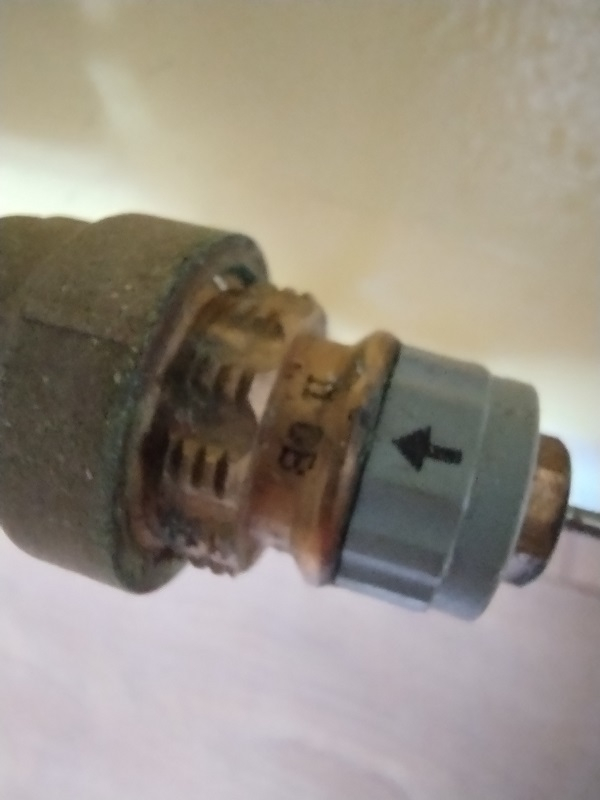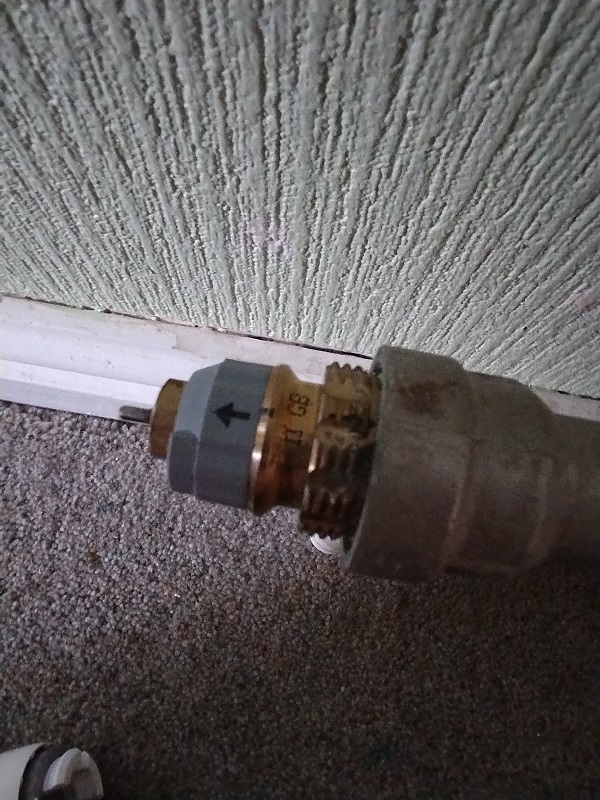We’d like to remind Forumites to please avoid political debate on the Forum.
This is to keep it a safe and useful space for MoneySaving discussions. Threads that are – or become – political in nature may be removed in line with the Forum’s rules. Thank you for your understanding.
📨 Have you signed up to the Forum's new Email Digest yet? Get a selection of trending threads sent straight to your inbox daily, weekly or monthly!
Flow Temperature or Thermostat or TRV or Lockshield Valve?
Comments
-
It is the return temperature that needs to be lower (ideally, under 50°C) - This condenses moisture out of the combustion gasses and returns heat to the water. If you don't have a grasp of thermodynamics, getting your head round the idea that condensing generates heat can be difficult.bery_451 said: Alright for proper condensing the flow and return temps cannot be the same? The flow or return, which has to be lower in temp?
Any language construct that forces such insanity in this case should be abandoned without regrets. –
Erik Aronesty, 2014
Treasure the moments that you have. Savour them for as long as you can for they will never come back again.0 -
By convention, the TRV is on the inlet pipe and the lockshield valve is on the outlet pipe but it doesn't matter if they are the other way around. Both of them, working in combination, control the flow rate of water through the radiator. We have told you repeatedly that water comes out of the radiator as fast as it goes in but you don't seem to be able to get your head around that idea.bery_451 said:False. The lockshield valve controls the maximum water flow rate through the radiator (at any given pump speed).
To clarify for better understanding each rad has 2 copper pipes connected to it. The one that goes into the TRV is that the flow pipe (bring water into the rad) and the one connected to the lockshield valve is the return (water leaving the rad) correct? If yes then the lockshield controls the return water or is it the flow water?Reed0 -
Yeah alright the TRV controls how much water goes in the Rad depending on the room temperature, whether the lockshield valve is fully opened or fully tightened water still leaves the Rad as the same rate as water going into the rad at the same time. They are both valves in sync at the same time in terms of water rate in ml or ltr entering & leaving the rad regardless of what position both of those valves are set. Is my understanding correct?Reed_Richards said:
By convention, the TRV is on the inlet pipe and the lockshield valve is on the outlet pipe but it doesn't matter if they are the other way around. Both of them, working in combination, control the flow rate of water through the radiator. We have told you repeatedly that water comes out of the radiator as fast as it goes in but you don't seem to be able to get your head around that idea.bery_451 said:False. The lockshield valve controls the maximum water flow rate through the radiator (at any given pump speed).
To clarify for better understanding each rad has 2 copper pipes connected to it. The one that goes into the TRV is that the flow pipe (bring water into the rad) and the one connected to the lockshield valve is the return (water leaving the rad) correct? If yes then the lockshield controls the return water or is it the flow water?0 -
No, still wrong. If the lockshield valve is fully tightened then there will be no water flow through the radiator and it will remain stone cold.bery_451 said:
Yeah alright the TRV controls how much water goes in the Rad depending on the room temperature, whether the lockshield valve is fully opened or fully tightened water still leaves the Rad as the same rate as water going into the rad at the same time. They are both valves in sync at the same time in terms of water rate in ml or ltr entering & leaving the rad regardless of what position both of those valves are set. Is my understanding correct?Reed_Richards said:
By convention, the TRV is on the inlet pipe and the lockshield valve is on the outlet pipe but it doesn't matter if they are the other way around. Both of them, working in combination, control the flow rate of water through the radiator. We have told you repeatedly that water comes out of the radiator as fast as it goes in but you don't seem to be able to get your head around that idea.bery_451 said:False. The lockshield valve controls the maximum water flow rate through the radiator (at any given pump speed).
To clarify for better understanding each rad has 2 copper pipes connected to it. The one that goes into the TRV is that the flow pipe (bring water into the rad) and the one connected to the lockshield valve is the return (water leaving the rad) correct? If yes then the lockshield controls the return water or is it the flow water?
Now suppose the lockshield valve is fully open and when the heating comes on the flow rate through the radiator is 10 litres per minute. As the TRV reaches its set temperature it will start to close off its valve it and the flow rate through the radiator will drop down to near zero.
Now consider the case when the lockshield valve is half open. Now the maximum flow rate through the radiator will be 5 litres per minute (instead of 10 litres per minute when it is fully open). Since the heat output from a radiator is proportional to the flow rate then the the radiator will give out a maximum heat of half what it did when the lockshield valve was fully open. As the TRV reaches its set temperature it will close off its valve and the flow rate will drop still further, further reducing the heat output from the radiator.Reed1 -
Reed_Richards said:
By convention, the TRV is on the inlet pipe and the lockshield valve is on the outlet pipe but it doesn't matter if they are the other way around. Both of them, working in combination, control the flow rate of water through the radiator. We have told you repeatedly that water comes out of the radiator as fast as it goes in but you don't seem to be able to get your head around that idea.bery_451 said:False. The lockshield valve controls the maximum water flow rate through the radiator (at any given pump speed).
To clarify for better understanding each rad has 2 copper pipes connected to it. The one that goes into the TRV is that the flow pipe (bring water into the rad) and the one connected to the lockshield valve is the return (water leaving the rad) correct? If yes then the lockshield controls the return water or is it the flow water?Correct, but I have some Danfoss TRVs which may be fitted to either the flow or return selected by turning a small collar.

0 -
One thing to understand when using a thermostat as well as TRVs is that when the room where the thermostat is situated gets to the set temperature, the boiler will be turned off even though one or more of the other rooms may not have reached the temperature set on their TRVs.Reed_Richards said:
Yes that is correct. The boiler will constantly use gas until such time as the return water temperature gets so high that it triggers the boiler to cut out as a safety feature.bery_451 said:Ok to confirm in a room where the rad TRV and thermostat wireless control is in the same room, the TRV has higher priority over the thermostat when it comes to air temperature for that room meaning the boiler will constantly use gas not turn off because the thermostat will sense a lower room temp than the set temp on the thermostat?
Yes, that is correct for ordinary TRVs. If you have programmable TRVs linked to your heating system it could be different. But you don't have those, do you?bery_451 said:
Can the same be said vice-versa, where the TRV setting is at max 5/6 position but the set temp on thermostat is lower than the TRV 5/6 position meaning it will stop the boiler using gas because room temp will get higher than set thermostat temp?
Yes, if the TRVs you are referring to are the one/ones in the same room as the room thermostat. You can set the TRVs in other rooms to whatever setting you like.bery_451 said:
So in summary it is better to put your TRV's in max 5/6 position to stop the risk of your boiler overheating and using tons of gas doing so?
Only in a system with Smart TRVs can each call for heat from the boiler0 -
That that could be avoided by rebalancing the valves.One thing to understand when using a thermostat as well as TRVs is that when the room where the thermostat is situated gets to the set temperature, the boiler will be turned off even though one or more of the other rooms may not have reached the temperature set on their TRVs.0 -
bob2302 said:
That that could be avoided by rebalancing the valves.One thing to understand when using a thermostat as well as TRVs is that when the room where the thermostat is situated gets to the set temperature, the boiler will be turned off even though one or more of the other rooms may not have reached the temperature set on their TRVs.As long as the radiator is appropriately sized for the room.Got one room here with an (on paper) oversized radiator. System properly balanced, yet still can't get the temperature up to a comfortable level.
Any language construct that forces such insanity in this case should be abandoned without regrets. –
Erik Aronesty, 2014
Treasure the moments that you have. Savour them for as long as you can for they will never come back again.0 -
@FreeBear : one section of my heating system (with two radiators) is prone to developing an airlock. This is not in the radiators themselves, which will send out water if you open the bleed valve. I've found that the way to cure the airlock is to temporarily close the valves to other radiators so the full pump pressure is directed to the airlocked pipe section. Something like that might be worth a try.Got one room here with an (on paper) oversized radiator. System properly balanced, yet still can't get the temperature up to a comfortable level.Reed0 -
Self-evidently they aren't balanced properly, or this wouldn't happen. There is a difference between radiators being correctly balanced, and correctly following a methodology intended to balance them.FreeBear said:bob2302 said:
That that could be avoided by rebalancing the valves.One thing to understand when using a thermostat as well as TRVs is that when the room where the thermostat is situated gets to the set temperature, the boiler will be turned off even though one or more of the other rooms may not have reached the temperature set on their TRVs.As long as the radiator is appropriately sized for the room.Got one room here with an (on paper) oversized radiator. System properly balanced, yet still can't get the temperature up to a comfortable level.
0
Confirm your email address to Create Threads and Reply

Categories
- All Categories
- 352.7K Banking & Borrowing
- 253.8K Reduce Debt & Boost Income
- 454.6K Spending & Discounts
- 245.8K Work, Benefits & Business
- 601.8K Mortgages, Homes & Bills
- 177.7K Life & Family
- 259.7K Travel & Transport
- 1.5M Hobbies & Leisure
- 15.9K Discuss & Feedback
- 37.7K Read-Only Boards







